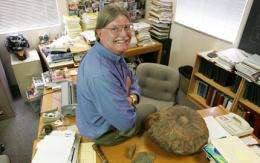And the microbes shall inherit the Earth

(PhysOrg.com) -- Global warming is not a novel phenomenon, and by studying what happened to the planet during a period of global warming about 250 million years ago, one USC Dornsife scientist hopes to discover what could happen to us this time around.
Of course, given that up to 90 percent of ocean species on Earth went extinct during that period, it’s not surprising that the news isn’t good.
“Science shows that the earth is changing,” said David Bottjer, professor of earth sciences and biological sciences.
Global temperatures are up almost three-quarters of a degree Celsius over the past 100 years, with documented increases in the amount of atmospheric carbon dioxide and other greenhouse gases.
Regardless of the cause, scientists must grapple with the question “Is this something to worry about or not?” Bottjer said.
To answer that question, Bottjer turned to the past, examining fossil evidence of the planet’s oceans from hundreds of millions of years ago. He presented his findings on Oct. 11 at this year’s annual meeting of The Geological Society of America in Minneapolis.
Historically, rapid increases in carbon dioxide in the past that were due to natural causes have led to mass extinctions.
The most severe of these extinctions occurred about 250 million years ago at the end of the Permian Period. Though the exact cause remains the source of debate, one theory is that the breakup of the supercontinent Pangaea drove increasing volcanic activity — activity that included magma erupting through coal deposits — which in turn dumped massive amounts of greenhouse gases such as carbon dioxide into the atmosphere.
As the planet warmed by as much as 5 degrees Celsius or more, animals and plants on land and up to 90 percent of ocean life on Earth died.
“As it gets hotter, there are predicted consequences,” Bottjer said. Putting it mildly, he added, “Life on land and in the sea is stressed.”
Bottjer made three main predictions based on observations of what is occurring today and what occurred in the past:
• More CO2 will be absorbed by the ocean, making it more acidic. Among other things, we can expect to see the die-off of coral reefs, which also occurred at the end of the Permian.
• Microbes will increase in abundance as other forms of life decline. “The animals are all dying off, and maybe the microbes get to take over,” he said. Though the coral will be gone, microbes will start building their own reefs in the ocean.
• A hotter atmosphere will slow ocean circulation. A slower ocean means less mixing, which in turn means that less oxygen is dissolved into the ocean. So called “dead zones,” where the ocean is anoxic and unable to support fish and other oxygen-dependant life, will appear. “We’re starting to see increasing oxygen minimum zones in the Pacific,” he said. “Expanding dead zones are developing off of Oregon and the Gulf Coast.”
Bottjer said he is not the only scientist turning his eye to the past for a glimpse at the future.
Other scientists perform similar studies using the Paleocene-Eocene Thermal Maximum, which occurred about 55 million years ago. The warming event resulted in a global temperature increase of several degrees Celsius, Bottjer said.
“Although it will not be a perfect analogue, the end-Permian mass extinction ocean has much to teach us about the future global-warming ocean,” he said.
Provided by USC College


















